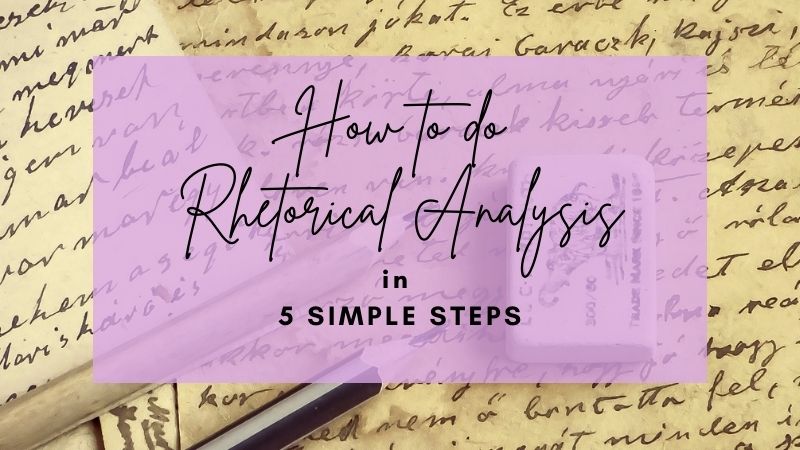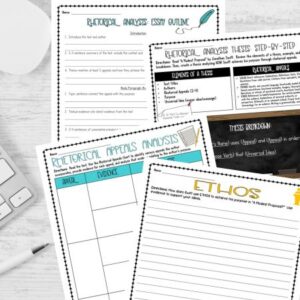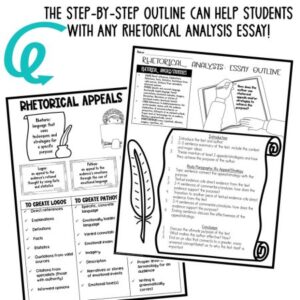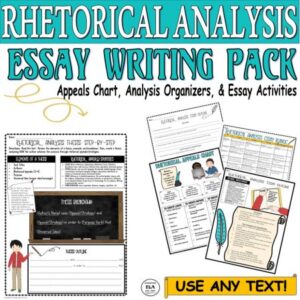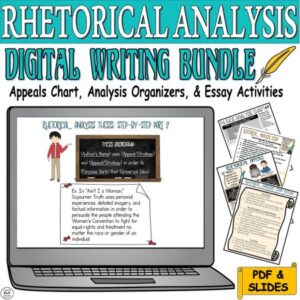No one EVER said teaching how to do rhetorical analysis was easy. In fact, it can be quite difficult!
We know we need to teach our students how to analyze texts and critically think about how an author gets his/her views across, but making it straightforward for students can be a tough endeavor. I don’t know about you, but I was never taught how to teach this. You would think with all of the Literature, Writing, and English Education classes, professors would have covered this important topic. But they didn’t.
Over the last 15 years of teaching, I realized ONE immutable fact; students NEED a step-by-step process that they can use for EVERY piece of rhetoric. Keep reading to learn How to do Rhetorical Analysis 5 Simple Steps!
Need help with Test Prep? Check out this FREE Pack of 3 Test Prep Activities to help students achieve success on standardized tests!
5 Simple Steps for How to Do Rhetorical Analysis
1. Give students a focus for reading
I personally like the S.P.A.U.T.S. method when teaching how to do rhetorical analysis; it is kind of like S.O.A.P.S.T.O.N.E., but it is MADE for informational texts!
S-Speaker: Who is the writer or speaker?
P-Purpose: What is the purpose of the text?
A-Audience: Who is the intended audience?
U-Universal Ideas: What are some major ideas from the text?
T-Tone: What is the tone of the author?
S-Strategies: What strategies does the author use to convey ideas?
Before you have your students read, introduce this acronym to help them focus on what they need to be successful for the rhetorical analysis essay.
MY FAVORITE TEXTS TO USE WHEN TEACHING HOW TO DO RHETORICAL ANALYSIS:
- A Modest Proposal
- Ain’t I a Woman
- Sinners in the Hands of an Angry God
- Sending Grandma to the Ovens
- The Declaration of Independence
- Gettysburg Address
- Declaration of Sentiments
Want to teach your students how to write a LITERARY ANALYSIS? Check out>>>Use Literary Analysis Examples in 5 STEPS!
2. Annotate as you read with your students
Personally, I like to focus on the second “S” (Strategies) part of S.P.A.U.T.S. for my annotation time as I teach how to do rhetorical analysis. You could choose ANY informational or nonfiction text to annotate.
Strategies could include anything from rhetorical appeals like logos, pathos, and ethos as well as the use of my favorites such as hyperbole, irony, rhetorical questions, metaphor, simile, oxymoron, repetition, a specific tone, structure, etc.
ANYTHING that an author uses is on the table for analyzing rhetoric. And really, there are no wrong answers. If you see a strategy and can use evidence that the author specifically employed that strategy for a reason, then it is a valid choice.
Steps for Annotation:
- Read small parts of a passage like a sentence, paragraph, chunk, or page.
- Think to yourself; what is the purpose of this part of the passage?
- Underline a piece of evidence that connects to the purpose.
- Take notes analyzing how the strategy is being used and label the strategy.
Check out this example from “A Modest Proposal!”
#1 Read the chunk:
CHUNK: Ex. But in order to justify my friend, he confessed, that this expedient was put into his head by the famous Salmanazar, a native of the island Formosa, who came from thence to London, above twenty years ago, and in conversation told my friend, that in his country, when any young person happened to be put to death, the executioner sold the carcass to persons of quality, as a prime dainty; and that, in his time, the body of a plump girl of fifteen, who was crucified for an attempt to poison the Emperor, was sold to his imperial majesty’s prime minister of state, and other great mandarins of the court in joints from the gibbet, at four hundred crowns.
Neither indeed can I deny, that if the same use were made of several plump young girls in this town, who without one single groat to their fortunes, cannot stir abroad without a chair, and appear at a play-house and assemblies in foreign fineries which they never will pay for; the kingdom would not be the worse.
#2 Think to yourself; what is the purpose of this passage?
Ex. Swift relays information about supposed examples of people who have sold children as food for the rich in order to bolster his argument that his “proposal” would be culturally acceptable. Ultimately, he uses this false tale to satirize those in power and criticize their desire to metaphorically consume those not worthy of their time or resources.
#3 Underline a piece of evidence that connects to the purpose.
Ex. “the body of a plump girl of fifteen, who was crucified for an attempt to poison the Emperor, was sold to his imperial majesty’s prime minister of state, and other great mandarins of the court in joints from the gibbet, at four hundred crowns”
#4 Take notes analyzing how the strategy is being used and label the strategy.
Ex. Swift uses a supposedly factual anecdote about the girl to substantiate his argument that his proposal could be applied to the kingdom of Ireland. As other countries have seemingly used children for food, it verifies the plausibility of enacting this plan specifically for the people of Ireland. Interestingly, this image creates a humorous impossibility that would horrify the audience, leading them to more realistic solutions.
3. Help students to use the answers from S.P.A.U.T.S. to create a thesis
The thesis should include the speaker, audience, purpose, strategies, and universal idea/message as this will make the process of how to do rhetorical analysis much simpler!
CLICK BELOW FOR A RHETORICAL ANALYSIS WRITING PACK YOU CAN USE WITH ANY TEXT!
4. Offer an outline to help show students how to do rhetorical analysis effectively
When we have done research on anything, we need to put the ideas into some sort of order. A step-by-step or even sentence-by-sentence outline can be so helpful!
You could have students arrange their essays in different ways:
- By strategy-each body paragraph could focus on a specific device, strategy, or technique
- By structure-each body paragraph could relate to a specific part (beginning, middle, end) of the rhetoric
- By idea-each body paragraph could focus on a specific idea or message from the author
You could also start out with a simpler essay structure to allow for student differentiation in length:
- 1 body paragraph
- 2 body paragraphs
- 3 body paragraphs
- 4 body paragraphs
Ultimately, you know your students. Think about what each needs and start where each student or group of students is!
CLICK THE LINK FOR A RHETORICAL ANALYSIS OUTLINE YOU CAN USE WITH ANY TEXT AS YOU TEACH HOW TO DO RHETORICAL ANALYSIS!
5. Encourage students to follow the outline for writing their rhetorical analysis essays
So often, students will write their outline, and then the essay looks totally different from what they initially outlined. Many times, students don’t realize that they can use all of the resources they have put time into to actually write their essays.
After they use the outline, you might even want to help them refine their ideas, structure, or overall writing a little by including these tips as they learn how to do rhetorical analysis.
- You could focus on embedding quotes.
- Maybe your students could highlight their analyses; if they don’t have at least 2 sentences after each quote, they could work on expanding their ideas.
- Offer students the use of an analysis verbs list to help with broadening their commentary. It is FREE in my store!
CLICK BELOW FOR A RHETORICAL ANALYSIS ESSAY GUIDE YOU CAN USE WHEN TEACHING HOW TO DO RHETORICAL ANALYSIS WITH ANY TEXT!
Why should we teach how to do rhetorical analysis?
More than anything, we want to guide our students in thinking about what someone is doing when he/she writes something…anything. You might not want to start out with satire. You could use an ad or simple narrative instead.
Meet your students where they are when beginning the journey of how to do rhetorical analysis!
Need more fun lessons and activities to help with how to do rhetorical analysis? Check out my store Kristin Menke-Integrated ELA Test Prep!

